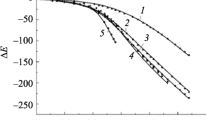Summary
The following silver(I) complexes ofN-ethylthiourea, L, have been isolated in the solid state: AgLX (X = Cl, Br, ClO4, BF4, and CF3CO2), Ag2L3X2 (X=ClO4, BF4 and CF3CO2), AgL2ClO4, AgL3X (X = Cl, Br, I, ClO4, BF4 and CF3CO2). The decrease of theν(CS) and σ(SCN2) frequencies in the i.r. spectra of the complexes indicates S-coordination of the ligands. Theν(AgS) frequencies lie in the 267–252 cm−1 range for terminal and 240-210 cm−1 range for bridged or “long” Ag-S bonds. The following structures may be proposed for the complexes. AgLX (X = Cl and Br), polymeric trigonal coordination with bridging halide ions; Ag2L3A2 (A = ClO4 and BF4), polymeric trigonal coordination with three bridging sulphur atoms; AgL2ClO4, polymeric tetrahedral coordination with four bridging sulphur atoms; AgL3A (A = ClO4 and BF4), dimeric tetrahedral coordination with two terminal and two bridging sulphur atoms; AgLO2CCF3 and Ag2L3(O2CCF3)2, trigonal and/or tetrahedral coordination with terminal sulphur bonds and bridging CO2 groups; AgL3O2CCF3, tetrahedral coordination with terminal sulphur bonds and a monodentate CO2 group. In the trifluoroacetato complexes, aν(AgO) band is observed at 185–209 cm−1. The AgL3X complexes (X = Cl, Br and I) show twoν(AgX) and twoν(AgS) bands with rather low frequencies corresponding to “long” metal-ligand bond distances.
Similar content being viewed by others
References
G. Peyronel, R. Battistuzzi and G. Debbi,J. Chroniatogr., 123, 367 (1976).
R. Battistuzzi, G. Peyronel and G. Debbi,Z. Anorg. Allg. Chem., 427, 274 (1976).
W. J. Geary,Coord. Chem. Rev., 7, 81 (1971).
G. B. Aitken, J. L. Duncan and G. P. McQuillan,J. Chem. Soc. A, 2695 (1971).
G. L. Bottger and A. L. Geddes,Spectrochim. Acta. 23A, 1551 (1967).
I. P. Evans and G. Wilkinson,J. Chem. Soc. Dalton Trans., 946 (1974).
M. R. Udupa and M. Padmanablian,J. Inorg. Nucl. Chem., 37, 1808 (1975).
M. Nardelli, G. F. Gasparri, G. G. Battistini and A. Musatti,Chem. Comm., 187 (1965).
W. I. Stephen and A. Townshend,J. Chem. Soc. A, 166 (1966).
E. A. Vizzini and E. L. Amma,J. Am. Chem. Soc., 88, 2872 (1966).
M. R. Udupa and B. Krebs,Inorg. Chitn. Acta, 7, 271 (1973).
W. S. Fyfe,J. Chem. Soc., 1032 (1955).
Y. Okaya and C. B. Knobler,Acta Crystallogr., 17, 928 (1964).
L. C. Capacchi, G. F. Gasparri, M. Ferrari and M. Nardelli,Chem Comm., 910 (1968).
M. J. Baille, D. H. Brown, K. C. Moss and D. W. A. Sharp,J. Chem. Soc. A, 3112 (1968).
S. K. Adams, D. A. Edwards and R. Richards,Inorg. Chim. Acta, 12, 163 (1975).
A. B. P. Lever and D. Ogden,J. Chem. Soc. A, 2041 (1967).
Author information
Authors and Affiliations
Rights and permissions
About this article
Cite this article
Battistuzzi, R., Peyrone, G. Silver(I) complexes ofN-ethylthiourea. An infrared study. Transition Met Chem 2, 87–91 (1977). https://doi.org/10.1007/BF01402692
Received:
Issue Date:
DOI: https://doi.org/10.1007/BF01402692



